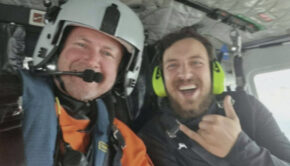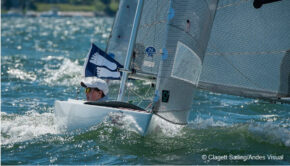When a man overboard isn’t a drill
Published on November 26th, 2018
During his first career in the British army with the Royal Artillery, Peter Crump was given the opportunity to sail offshore. This taste led to a keen interest in seeing the coastline fade off, but also with the safety side of the sport.
On departure from the Army in 1988 he set up his own RYA recognised Offshore Sailing School, and now at 75 years of age, his accrued wisdom – enhanced by eleven Fastnet Races – comes from being an RYA Yachtmaster Instructor for 30 years and an Examiner for 20.
He still has a keen interest in the training side of sailing and shares some nuggets here:
“Teaching novices caused me to think long and hard at how I could mitigate the problem that complete beginners would have to face should the Instructor fall overboard. Under sail on morning one of day one, students were shown how to put the helm over and lock it such that the yacht would spin on its own axis and continue so to do until such time as the helm was altered.
“In the meantime, the two scramble nets were released (they were permanently attached amidships), and as the Instructor in the water, I now needed to swim to the yacht which of course was not very far away and simply going round in circles. At the appropriate moment I needed to grab a scramble net, hold on and in due course climb up the net and back into the yacht. A possible calamity was resolved as far as it is resolvable.
“My aim in teaching was to get students to aspire to becoming a ‘Good Seaman’. I defined a good seaman as a person who resolved the problems before they occurred. In my experience it takes about 50,000 miles of offshore sailing to arrive at that point. Having done so all subsequent errors and failures can usually be put down to ‘complacency’.”
Not familiar with Scramble Nets? Here’s more of Peter’s advice:
1. Man Overboard.
The sailing drill for MOB is usually well taught and understood by most sailors. Good skippers practice the drill on a regular basis with their crew such that the drill becomes a habit. However, rarely do skippers practice retrieving a live body from the water and consequently have little idea just how difficult the problem can be. In essence if a person goes in the water, 20% of the problem is returning the yacht alongside the person in the water and 80% is retrieving the body from the water.
2. The Problem.
There are essentially three circumstances that determine the difficulty of extracting a man from the water;
a. Sea state
b. The height of the topsides of the yacht and
c. The number of crew available to help.
3. Equipment.
The effectiveness of proprietary equipment with which most yachts are fitted such as the tri-buckle and the Jon Buoy with life sling are very largely dependent upon the numbers of crew available and having a benign sea state. Few skippers have practised using the equipment with a live body.
A few years ago on a Fastnet race, a skipper deployed his Jon Buoy life sling for real – the Jon Buoy destroyed the yachts steering and it wasn’t long before the line to the buoy went around the prop! I know the person who designed the tri-buckle and I also know that the equipment never received a proper trial, i.e. tried in a moderate to rough sea-state.
4. Transom Extraction.
Most modern yachts have a cut away transom with or with out bathing platform. Extracting a person using the bathing platform will work provided that the sea-state is smooth. The pitch of a yacht is greatest at the ends and least about the natural pivot point of the yacht. Using the transom has a very limited application.
5. Commonly Quoted Methods.
In discussion skippers suggest such solutions as attaching a halyard to the person in the water or detaching the inboard end of the main sheet, swinging the boom out, and then attaching the free end of the main sheet to the person in the water. Then in both cases using increased mechanical efficiency to raise the person from the water.
The effectiveness of these solutions is solely dependent upon a benign sea-state and available numbers. Bearing in mind that MOB is statically likely to occur in a F6 or greater associated sea-state. If in doubt, try to set up these methods in the Needles Channel with an ebb tide and a SWly F6.
6. Self-Help.
None of the methods suggested thus far allow the person to help himself. Self-preservation is a massive motivator. Any recovery system that allows the person in the water to assist in the extraction stands a superior chance of being successful.
A very simple system that I have used in relatively benign conditions is to drop the jib sheet down the topsides and into the water – one end remaining attached to the jib and the other around the winch. The person in the water, using the ship’s hull for balance, then places the sheet under his feet and the sheet is then winched in lifting the person up the side of the ship. With assistance from those on board, the person is quickly returned to the yacht.
7. All Eventualities.
The approaches mentioned above have severe limitations and are totally unsuited to cover most, let alone all, eventualities. A satisfactory system has to be able to cope with a weak crew both in terms of numbers and strength bearing in mind that with a person in the water the numbers have dropped by a further one.
Such a scenario might be Mum, Dad and a couple of children aged 10 to 14-years old. For whatever reason Dad goes in the water, Mum is well taught and quickly returns the yacht along side Dad in the water. Mum can either deploy the life raft (topsides about a foot) into which Dad can climb and thence back onto the yacht or if fitted, deploy the scramble net on the appropriate side.
In the first instance Dad can grab the net and re-attach himself to the yacht. Self-preservation takes over and it is highly likely that Dad will find the wherewithal to scramble up the net and back on board. Note: for the system to be effective nets must be fitted to both sides of the vessel so that the Velcro is opened in an instant and the net falls overboard in a deployed state.
Statistically, very few people go into the water in an unconscious state. This represents the most difficult problem of all. Nevertheless, the design of the net is such that it can be turned into a par buckle and/or will take one or two able crew using it either side of a casualty to assist.
8. Other Comments.
A study of MAIB reports over the past 15-years shows that about half a dozen lives have been lost because crew could not recover the man in the water due to the height of the top sides despite placing the vessel along side the casualty promptly.
9. In Summary.
In MOB the first 20% of the problem is resolved when the vessel is returned along side the casualty, with the casualty grabbing hold of the net and hence re-attaching himself to the vessel – 75% of the problem has been resolved. Finally self-preservation being the motivator, the casualty clambers back on board with or without assistance.









 We’ll keep your information safe.
We’ll keep your information safe.